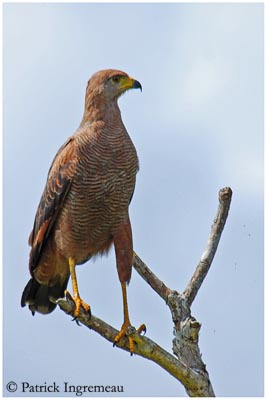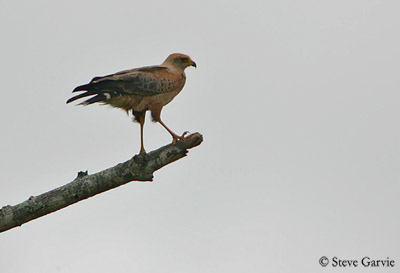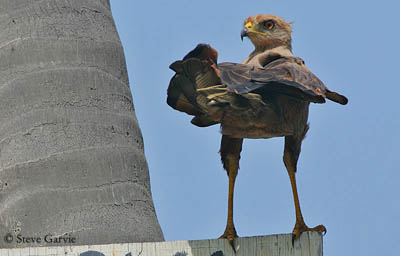
Savanna Hawk
Buteogallus meridionalis
Accipitriforme Order – Accipitridae Family
BIOMETRICS :
Length : 46-60 cm
Weight : 825-1070 g
DESCRIPTION:
Savanna Hawk is a bird of prey with very long broad wings, long legs and short tail.
Female usually lays one egg, occasionally two. Incubation lasts about 39 to 40 days.
Young fledge about 45 to 50 days after hatching. They remain within the parental territory after fledging, until they become independent, which means four to seven months after leaving the nest.
Eggs and chicks can be preyed upon by large raptors, or arboreal mammals and snakes, involving nest failure. If the nest failure occurs at the beginning of the rainfall, the pair can nest again one or two months later.
DIET:
Savanna Hawk is an opportunistic feeder, and it feeds on varied food items such as snakes, fish, lizards, frogs, small mammals, birds, large insects, caterpillars, grasshoppers, ants and spiders.
It hunts from exposed perch, but also in flight or walking on the ground.
PROTECTION / THREATS / STATUS:
Savanna Hawk is uncommon to common according to the range. Populations are secure and this species is not threatened at this moment.
Fr: Buse roussâtre
All: Savannenbussard
Esp: Busardo Sabanero
Ital: Poiana delle savane
Nd: Savanne-buizerd
Russe: Болотный канюк
Port: Gaviao-caboclo
Photographs by Steve Garvie
His website : RAINBIRDER Photo galleries
Photograph by Patrick Ingremeau
His website :
TAMANDUA
Text by Nicole Bouglouan
Sources:
HANDBOOK OF THE BIRDS OF THE WORLD Vol 2 by Josep del Hoyo-Andrew Elliot-Jordi Sargatal - Lynx Edicions - ISBN: 8487334156
A GUIDE TO THE BIRDS OF COLOMBIA by Steven L. Hilty and William L. Brown
Princeton University Press – ISBN 069108372X
Wikipedia (Wikipedia, The Free Encyclopedia)
The Hawk Conservancy Trust (Hilary Smith)
SORA Searchable Ornithological Research Archive (Blair O. Wolf)
Discovering the birds of Trinidad and Tobago (Brian Ramsey)

Adult male has dusky grey-brown back, edged reddish. Rump and tail are black. Tail shows only one median white band and white tip. Wings are rufous, with broadly tipped black flight feathers, mostly primaries and secondaries.
The underparts are rufous, narrowly barred blackish from upper breast to lower belly. Undertail coverts are pale rufous. Undertail is similar to uppertail. On the underwings, coverts are rufous. Flight feathers are rufous finely barred blackish and broadly edged with black.
On the head, forehead, crown and nape are rufous. Hind neck is streaked. Chin and throat are pale rufous. Cheeks are buffy-grey. Cere and lores are yellow. Bill is tipped black. Eyes are reddish-yellow. Long legs and talons are orange-yellow.
Both sexes are similar, but female is larger than male.
Immature is rather sooty brown on the upperparts, with mottled rufous shoulders. Underparts are buff, streaked dusky on the breast, and barred on belly and thighs. On the head, it has a conspicuous white eye stripe.
VOICE: SOUNDS BY XENO-CANTO
Savanna Hawk sometimes utters a shrill “keeeeeru”. When the pair is circling about, it utters a grating “kweh kweh”.
HABITAT:
Savanna Hawk frequents wooded and palm savannahs and swamps’ edges in tropical and subtropical regions. It is also found at forest edges and in mangroves. It is often near water. This species is visible up to 1000 metres of elevation in Colombia. It prefers open country where it is often observed.
RANGE:
Savanna Hawk is mainly resident in most part of its range, from Panama, the Guyana and Trinidad, to Colombia, Bolivia, Uruguay, Central Argentina and Brazil.
BEHAVIOUR:
Savanna Hawk feeds on wide variety of items, such as reptiles, fish, amphibians, small mammals, birds, large insects and spiders. According to the range and the season, it may feed on eels and crabs too.
Savannah Hawk hunts from low perch in tree or any other place. It also swoops on prey while flying, and often walks on the ground, thanks to the long legs.

This species frequently follows grass fires, hunting for escaped animals. Very conspicuous in open country, the Savanna Hawk sometimes forms flocks of several dozens according to the food resources. It also may perform piracy from other birds. It is an opportunistic feeder.
When breeding season starts, we can see two or three hawks soaring and circling high in the air, while they utter their shrilling calls. They also bring nest materials during the flight displays.
When the Savanna Hawk is alarmed, it slightly erects the nape feathers, giving an almost crested appearance.
Savanna Hawk is resident in most part of the range, but some populations perform movements, according to the food resources and water levels.
FLIGHT:
Savanna Hawk has agile flight, as when hunting at moderate elevation, or when circling high in the sky during the flight displays. It has long broad wings allowing easy flight.
REPRODUCTION:
Breeding season varies according to the geographic range, but Savanna Hawk breeds during the wet season.
The nest is built with sticks in isolated tree, sometimes a thorny tree if available, or in mangroves. The platform is reused year after year.
The nest-site includes a hunting area which is defended against other birds of prey, and also a soaring range where both adults can fly over their territory.
